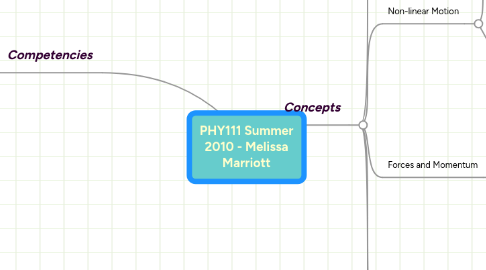
1. Concepts
1.1. Linear Motion
1.1.1. Terms
1.1.1.1. Position - where it is (relative to origin)
1.1.1.2. Displacement - movement from position to position
1.1.1.3. Speed - how fast something is moving (displacement per time)
1.1.1.4. Velocity - vector, has magnitude and direction
1.1.2. Skills
1.1.2.1. Motion diagrams
1.2. Non-linear Motion
1.2.1. The motion exemplified in the first project, object moves parabolically
1.2.2. Skills
1.2.2.1. LoggerPro Analysis
1.2.2.2. Diagrams and Charts
1.2.2.2.1. Situation
1.2.2.2.2. Force
1.2.2.2.3. P vs. T
1.2.2.2.4. V vs. T
1.2.2.2.5. A vs. T
1.3. Forces and Momentum
1.3.1. Terms
1.3.1.1. Force - anything that causes an object to undergo acceleration
1.3.1.2. Momentum - mass of an object times its velocity
1.4. Work, Energy Storage and Transfer
1.4.1. Terms
1.4.1.1. Elastic Potential Energy - energy needed to compress or expand a spring
1.4.1.1.1. Hooke's Law: F = -kx
1.4.1.2. Kinetic Energy - energy needed to accelerate an object
1.4.1.2.1. E = (1/2)mv^2
1.4.1.3. Gravitational Energy - energy exerted on one object by another
1.4.1.3.1. E = mgh
1.4.2. Skills
1.4.2.1. How energy transfers from one state to another
1.4.2.1.1. Example: Elastic energy from rubber band transfers to kinetic energy in marshmallow launch
1.4.3. Since energy is never lost or created, it must be transferred in different forms or to different objects within the system
1.5. Properties of Matter
2. Competencies
2.1. Effectively communicate qualitative and quantitative information orally and in writing.
2.1.1. Neat Videos and email correspondences help to solidify ideas while also improving communication skills
2.2. Explain the application of fundamental physical principles to various physical phenomena.
2.2.1. Group projects encourage students to use what they know to build functional representations of their knowledge and analyze them, neat videos show how universally applicable concepts in physics can be
2.3. Apply appropriate problem-solving techniques to practical and meaningful problems using graphical, mathematical, and written modeling tools.
2.3.1. LoggerPro Analysis of video motion, using Excel to calculate and formulate charts modeling motion, transfer findings to VPython to code 3D models of situations
2.4. Work effectively in collaborative groups.
2.4.1. Group projects help students to coordinate ideas and delegate tasks that are suited for each student's skill set, while also helping all to understand concepts more fully
